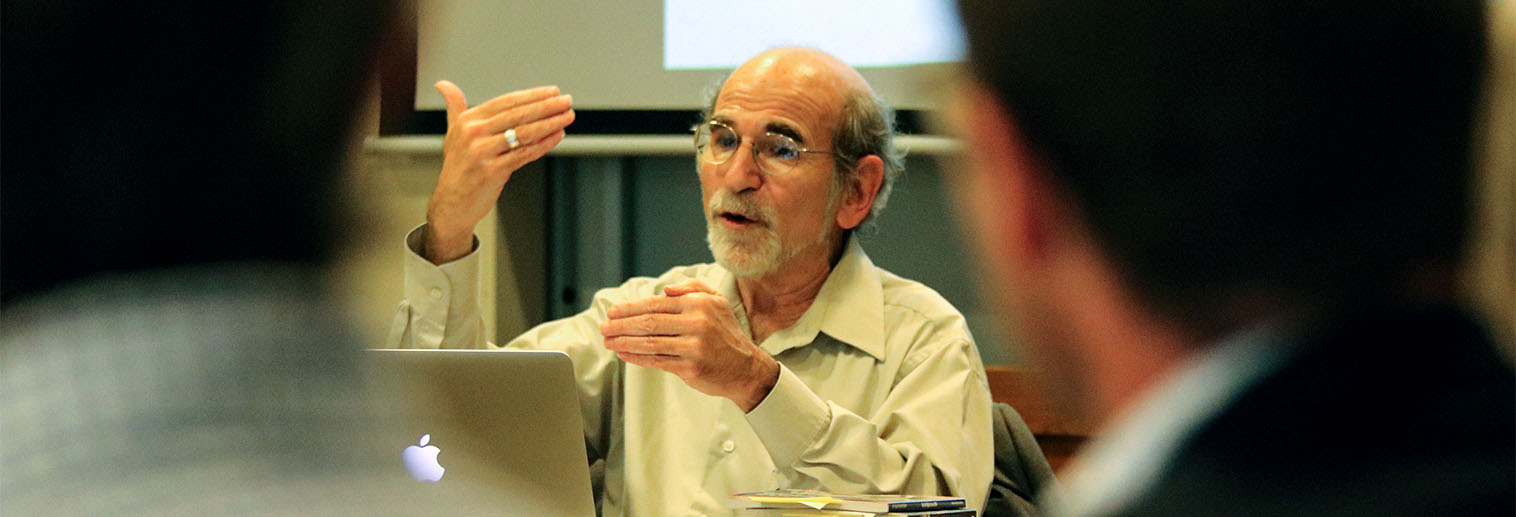Shining New Light on the Civil Rights Movement
Robert Mayer, professor of education, leads a thoughtful exchange on civil rights, how to engage students with this history, and the ways into truth.
If you were to reduce the civil rights movement to a sound byte, it might go like this: “Dr. King gave a speech, we have civil rights, and we don’t have to worry about it anymore,” suggests Bob Mayer, professor of education and civil rights scholar. Unfortunately, the way many Americans view or are taught the civil rights movement is not much broader or deeper than that. “I want to crack the traditional narrative, “ says Mayer whose life’s work has centered on opening up new ways into this history for students. Mayer shared his work at the November 19th faculty luncheon, “Writing about the Civil Rights Movement for Young People: Teaching Inequality.”
To illustrate how he is constructing new narratives around the civil rights movement, Mayer turns to the canvas of his two books, The Civil Rights Act of 1964 (Greenhaven Press, 2004) and When the Children Marched: The Brimingham Civil Rights Movement, and explains the tools that have allowed him to bring new images to the forefront and create a more complete portrait of this period in history.
New Voices
Who spoke for African Americans during the civil rights movement? John F. Kennedy, Hubert Humphrey and Martin Luther King Jr. among others, but there is a dearth of black voices represented in history textbooks. Martin Luther King, Jr., figures most prominently, and with good reason. “When you read interviews with domestic workers, they were awed by him,” says Mayer. “He was part of the black intellectual tradition, and he put together important ideas. He stands among the country’s great leaders because of his ability to grow through very difficult times, just like Lincoln.
“But the civil rights movement is not just about the leaders,” adds Mayer. “The civil rights movement is part of the democratic process. It grew out of powerful communities in the south, filled with love and connection. We tend to see the black men and women of this time as victims, but they came together to move a country toward change.”
Among other significant but little-known voices is that of John Lewis, who at the age of 23 spoke at the March on Washington, where roughly 300,000 gathered as the Civil Right act was debated in Congress. “His speech was very important and tends to get left out of textbooks,” says Mayer who shared this prescient passage from Lewis’s oration: “In good conscience, we cannot support wholeheartedly the administration’s civil rights bill, for it is too little and too late. There’s not one thing in the bill that will protect our people from police brutality.”
Lived Experience
If we are to draw students into history, we need to engage them in the narrative, Mayer points out. Most history texts elicit yawns rather than engage eyeballs, but a good read isn’t always a truthful one. It can be a struggle to write an absorbing story that’s also honest. Mayer pulls from what he calls lived experience such as this in the description of the bombing of civil rights leader Reverand Fred L. Shuttlesworth’s home in Birmingham, Alabama, in 1956:
The blast echoed throughout the neighborhood. They had bombed the reverend’s home on Christmas night. James Roberson, a young parishioner who lived across the street, felt the shock in his own bedroom: “I was home in bed. The explosion was so powerful, I thought the world was coming to an end.” When Roberson gaped at the house, he saw a terrifying sight. A pillar had been torn from under the roof and the swelling leaned to the left. Roberson feared for the people inside. From the street below he heard screaming.
—When the Children Marched, by Robert H. Mayer
Mayer evokes settings such as when he writes about the “hot and muggy” morning of Monday, May 6, 1963, the 5th day of marching by students through the streets of Birmingham, “when the temperature rose to ninety degrees.”
He uses setting, dialog, lived experience, multiple views and viewpoints because the human experience is multiple dimensional, and this is the way we and our students can find our way into history and its truth and learn from it.
Bob’s Books of Note
On issues of rights, Robert Mayer, professor of education, enthusiastically recommends these two works.
Between the World and Me by Ta-Nehisi Coates
Coates’s memoir, written as letters to his son, explores what it means to be black in America. It won the 2015 National Book Award for Nonfiction.
The Secret History of Wonder Woman by Jill Lepore
“In [Lepore’s] hands, the Wonder Woman story unpacks not only a new cultural history of feminism, but a theory of history as well.” —Carla Kaplan, New York Times Book Review

